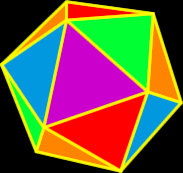|
3║ ESO POLYHEDRA PLATONIC AND ARCHIMEDEAN SOLIDS
|

dictionary-polyhedron
|
 dictionary-polyhedron |
|
DEFINITION A polyhedron (plural polyhedra) is a geometric solid in three dimensions with flat faces and straight edges. The word polyhedron comes from the Classical Greek. Click on LINK 1 to learn how polyhedra are named. Click on LINK 2 to know some polyhedra. REGULAR CONVEX POLYHEDRA (PLATONIC SOLIDS) Discover the regular convex polyhedra. Only five are possible. Can you see what they have in common? How are their faces, edges and vertices? Click on LINK 3 DUALITY For every regular polyhedron there exists a dual polyhedron having: * faces in place of the original's vertices and vice versa * the same number of edges * the same Euler characteristic and orientability Click on LINK 4 ARCHIMEDEAN SOLIDS Learn more about other polyhedra. The Archimedean polyhedra are polyhedra with regular polygon faces. Faces may be of different types but all the vertices are identical. Faces must be arranged in the same order around each vertex. Click on LINK 5 to discover the Archimedean solids. Click on LINK 6 to compare Archimedean and Platonic polyhedra. EULER AND THE EULER┤S FORMULA Find out who was Euler and how is the Euler┤s formula. Apply the formula to different polyhedra. Click on LINK 7 TRUNCATING Truncations are the main method of changing a regular polyhedron into a new semi-regular polyhedron. The word "truncate" is specifically the act of symmetrically slicing away pieces. Click on LINK 8 and have fun transforming solids. POLYHEDRA WORKSHOP Construct your own solids. Click on LINK 9 to work with paper. Click on LINK 10 and on LINK 11 to go on working in a very different way. ASSESSMENT Click on LINK 12 to take a quizz and test how much you have learnt. |
Links: |